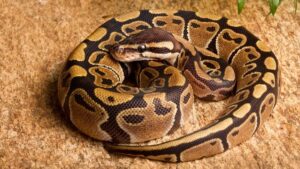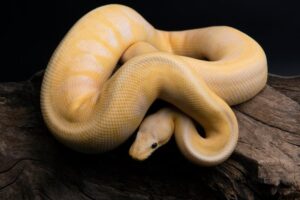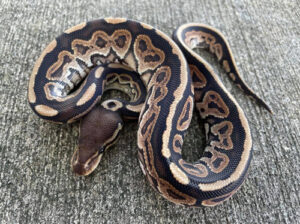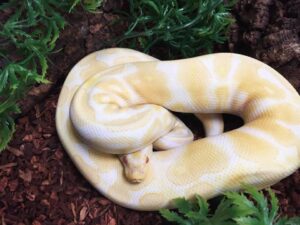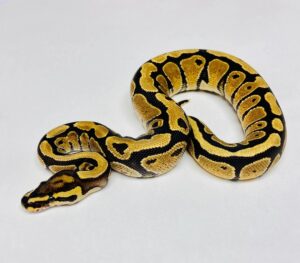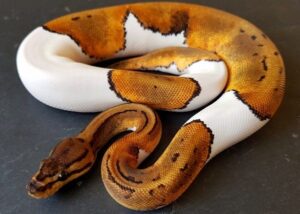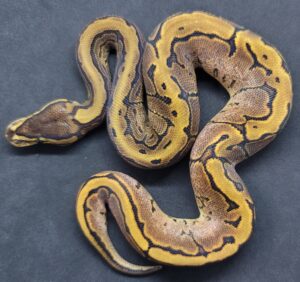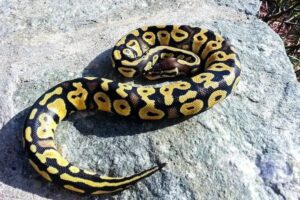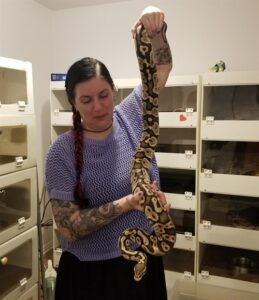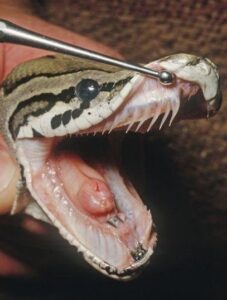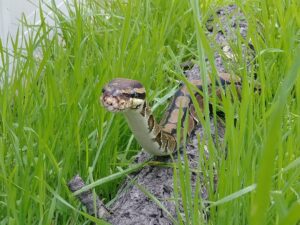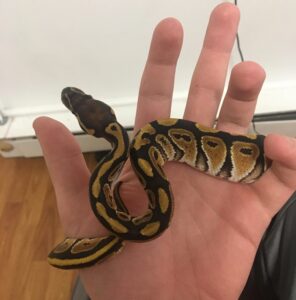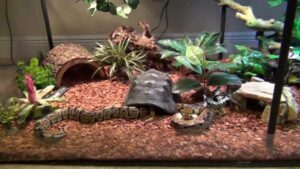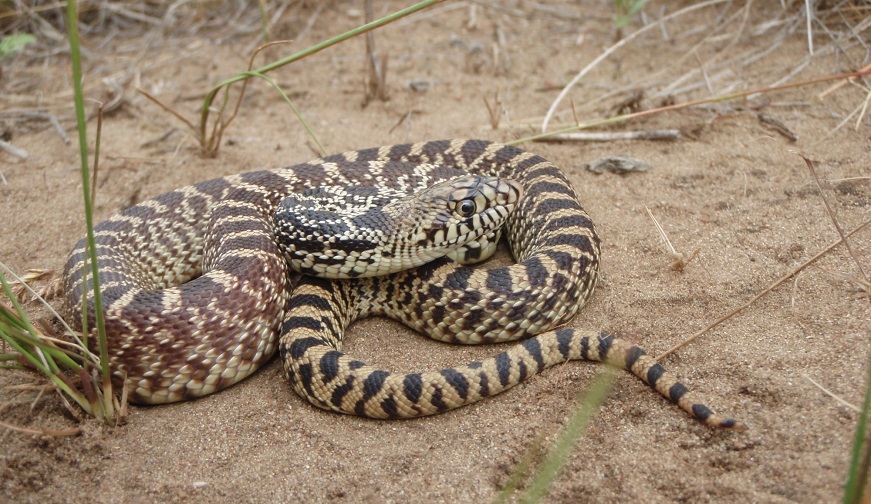The ball python or royal python is endemic to Central and West Africa. The constrictor is the smallest African python and is typically crepuscular or nocturnal. Though a bit shy, it is an ideal captive due to its small size, friendliness, manageable levels of care needed, and the remarkable array of colors and patterns in which it is available.
The ball python has considerable cultural significance. Igbo people in southeastern Nigeria hold it in high regard since they symbolize it as the earth as it travels so close to the ground. Even Christian Igbos treat the snake with great care. They either let it roam freely or pick it up gently and return it to a field or forest away from their homes. If a ball python is accidentally killed, many Igbo communities still build a coffin for the dead snake and organize a short funeral.
The people of northwestern Ghana consider it their savior and cannot hurt or consume it. It is because, according to folklore, a ball python once helped them flee their enemies by changing itself into a log, allowing them to cross a river.
Scientific Classifications
- Suborder:Serpentes
- Family:Pythonidae
- Genus:Python
- Species:P. regius
Conservation Status
Morphs
The pets are frequently bred for specific patterns that don’t occur naturally. Breeders continuously make new designer morphs, and over 7500 morphs exist. Most of them fulfill solely cosmetic purposes causing no benefit or harm to the snake. However, the spider morph gene has been associated with a neurological disease related to its sense of balance. That is why the International Herpetological Society banned the sale of this morph in 2018.
The top ball python morphs are as follows.
- Albino (Amelanistic)
- Caramel Albino
- Axanthic
- Piebald
- Pastel
- Spider
- Cinnamon
- Champagne
- Fire
- Ghost
- Lesser Platinum / Butter
- Yellow Belly
- Pinstripe
- Mojave
- Clown
- Scaleless
- Black Pastel
- Banana / Coral Glow
- Leopard
- Enchi
Description
Size
It reaches a maximum length of 6 ft (182 cm). The males typically measure 8-10 subcaudal scales, while the females measure 2-4 such scales. The average snout-to-vent length of the females is 45.75 in (116.2 cm) with a 1.75 in (4.43 cm) long jaw and a 3.43 in (8.7 cm) long tail. Their maximum weight is 3 lb 9.7 oz (1.635 kg). The males are smaller, with an average snout-to-vent length of 43.8 in (111.3 cm), a 1.72 in (4.36 cm) long jaw, and a 3.38 in (8.6 cm) long tail. Their maximum weight is 3 lb 7 oz (1.56 kg).
Both sexes have pelvic spurs on both sides of the vent. The males tend to have longer spurs and use them for gripping females during copulation.
Color and Appearance
The ball python is dark brown, black, or albino, with light brown blotches on the sides and back. Its cream or white belly has scattered black markings. The stocky snake has smooth scales and a relatively small head. Both sexes have pelvic spurs on the sides of the vent, but the male’s are larger and used for grabbing the female during copulation.
They have small, sharp teeth that are curved inward. The actual number varies, but most commonly, they have around 30 teeth. But they don’t hurt much when the snake bites as it lacks powerful jaws. The wound created is minor and feels like a series of pinpricks. There are no fangs.
Are They Dangerous to Humans
This species is best known for its defensive strategy of coiling into a tight ball, with its head and neck tucked away in the middle when threatened. Hence its common name. As it exhibits this behavior instead of biting, it can be handled easily, contributing to its popularity as a pet.
Ball Pythons at a Glance
Distribution
It ranges in west Sub-Saharan Africa from Mali, Senegal, Guinea-Bissau, Sierra Leone, Guinea, Liberia, Ghana, Ivory Coast, Benin, and Nigeria through Chad, Cameroon, and the Central African Republic to Uganda and Sudan.
The species is subjected to high levels of exploitation, and its population is believed to be on the decline in most of West Africa. It is primarily threatened by poaching for the exotic pet trade. It is also hunted for its meat, skin, and usage in traditional medicine.
Other threats include habitat loss due to intensified pesticide use and agriculture. The rural hunters in Togo collect the egg clutches and gravid females that they sell to snake ranches. In 2019 alone, 58 interviewed hunters collected 5000 eggs and 3000 live ball pythons.
Habitat
It lives in open forests, shrublands, and grasslands. It prefers sparsely wooded areas and savannas, apart from grasslands. In the wild, the ball python favors mammal burrows and other underground hiding places where it also aestivates. The males display more semi-arboreal behavior, while females are more terrestrial.
Lifespan
They live for as long as 10-15 years in the wild. The species does particularly well in captivity living up to 15-30 years with good care. The maximum recorded lifespan of a pet is 62 years.
Predators
The main predators of the python are birds of prey, black cobras, carnivorous mammals, and humans.
Diet
It eats birds and small mammals. Rodents like black rats, Gambian pouched rats, rufous-nosed rats, striped grass mice, and shaggy rats comprise a major part of its diet. But young ball pythons that measure less than 28 in (70 cm) mainly prey on small birds. On the other hand, snakes longer than 39 in (100 cm) mostly prey on small mammals. The males prey more often on birds, and the females more on mammals.
Reproduction
Oviparous (lays eggs that hatch outside the body)
A female lays 3-11 big, leathery eggs per clutch. They hatch after 55-60 days. The young males reach sexual maturity at 11-18 months, while the females do the same at 20-36 months.
Age is only one factor in deciding sexual maturity and breeding ability. Weight is another factor. The males breed when they weigh 21 oz (600 g) or more. But in captivity, some males begin breeding at 11-14 oz (300-400 g) weight. Females mate in the wild when they weigh as low as 28 oz (800 g) though most do so when they are 42 oz (1200 g) or more. In captivity, breeders usually wait till they are no less than 53 oz (1500 g).
There is no parental care for the babies after they hatch, as the females leave the offspring to fend for themselves.
Care Sheet
Ball pythons are the most popular pet snake and the second most popular pet reptile after the bearded dragon. While the captive-bred specimens are widely available in the pet trade, capturing the wild snakes for sale continues damaging their population in the wild. The wild specimens face more challenges adjusting to captivity which can result in refusal to feed. Plus, they are generally carriers of internal or external parasites.
Size of the Enclosure: An adult ball python can be comfortably housed in a tank of dimensions 48-inch (length) x 24-inch (width) x 24-inch (height). Two or more hides and shelters are needed in the cage.
Temperature: The temperature should be maintained at 95°F at the hot end and 78°F at the cool end. The basking spot should be maintained at 88-96°F. The ambient temperature should not fall below 75°F.
Humidity: It needs humidity levels of 40-60%. A 70% humidity level is suitable for shedding. A shallow bowl of fresh, clean water large enough for the pet to soak in should always be in the cage.
Substrate: Reptile carpet, aspen wood shavings, forest bedding, and paper-based bedding are ideal choices for the substrate. Pine and cedar should not be used as bedding as they irritate the python’s skin.
Feeding: The captive should be given appropriately sized frozen rodents (like rats), warmed or thawed to above room temperature, to eat. The size of the prey should be approximately the width of the snake at mid-body. The juveniles should be fed once a week and the adults every 1-2 weeks.
FAQs
Ans. An adult ball python can go without feeding for as long as six months. But going without food for such a long time can be disastrous for the snake’s health. Having said that, the wild specimens starve for such extensive periods as they cannot acquire food.
Ans. The adults shed every 4-6 weeks. As shedding is a natural outcome of growth, it occurs more often in babies.
Ans. A regular ball python can cost as little as $20. But if you are looking for a specific morph with unique designs, you might have to shell out more than $200. The most expensive ball pythons can have a price tag of $10,000+.
Ans. Though ball pythons don’t need UVB to live, UVA/UVB light in the pet setup has shown to greatly improve the health, immune system, and wellness of reptiles, in general. So you can use one to create the hot side of the tank.
Source
mypetreptiles.com, reptiledirect.com, bigcommerce.com, bhbreptiles.com, reptileguide.com, morphmarket.com, everythingreptiles.com, ball-pythons.net, lllreptile.com, quora.com, oaklandzoo.org, reddit.com, reptpedia.com

